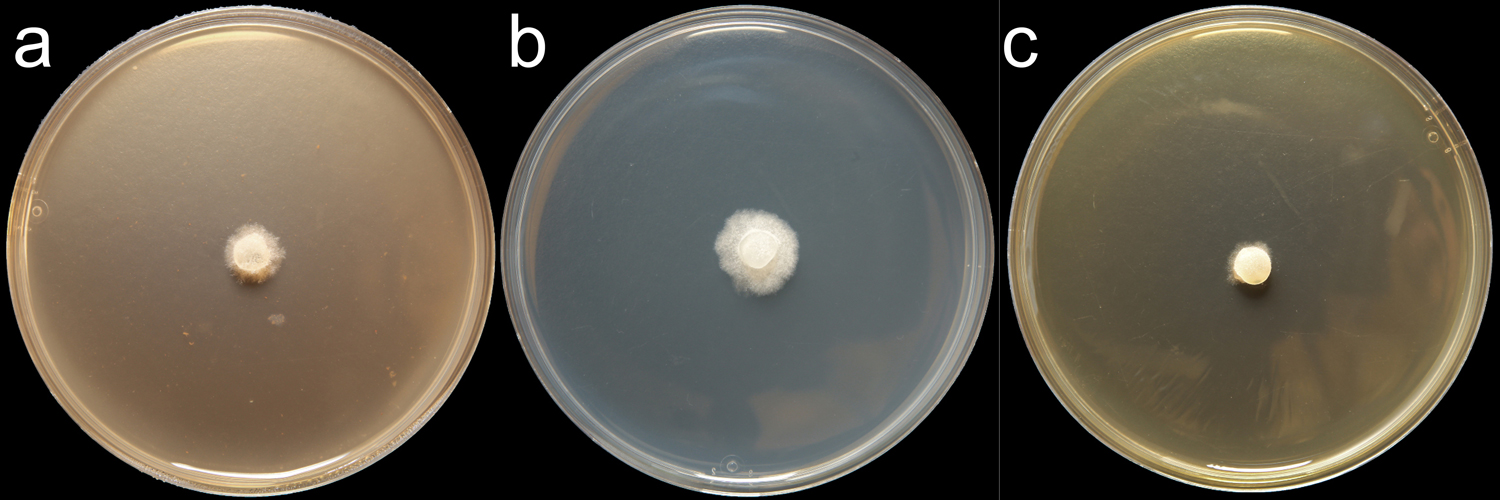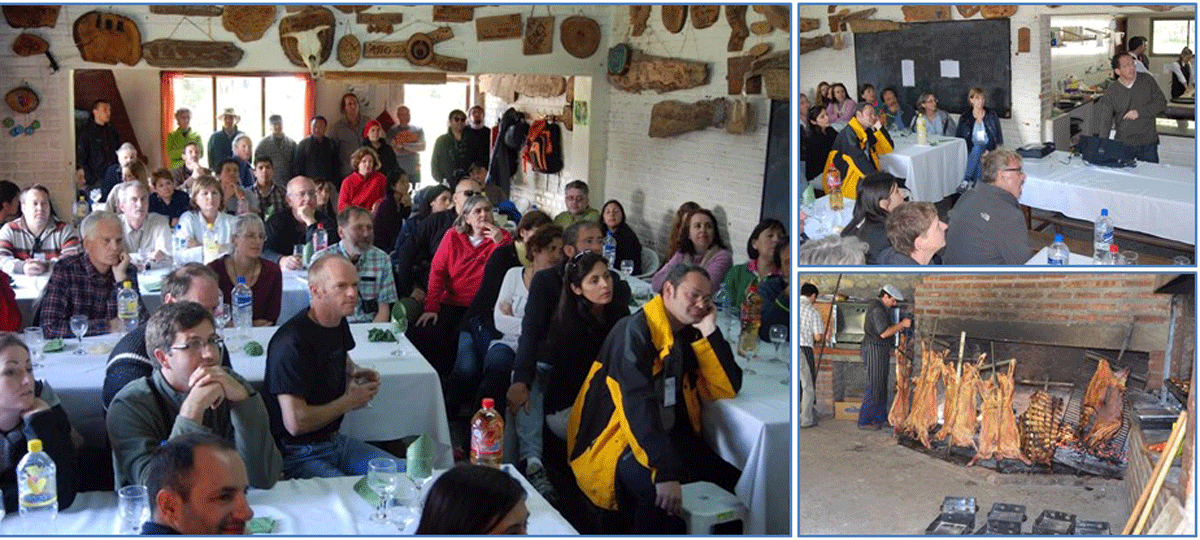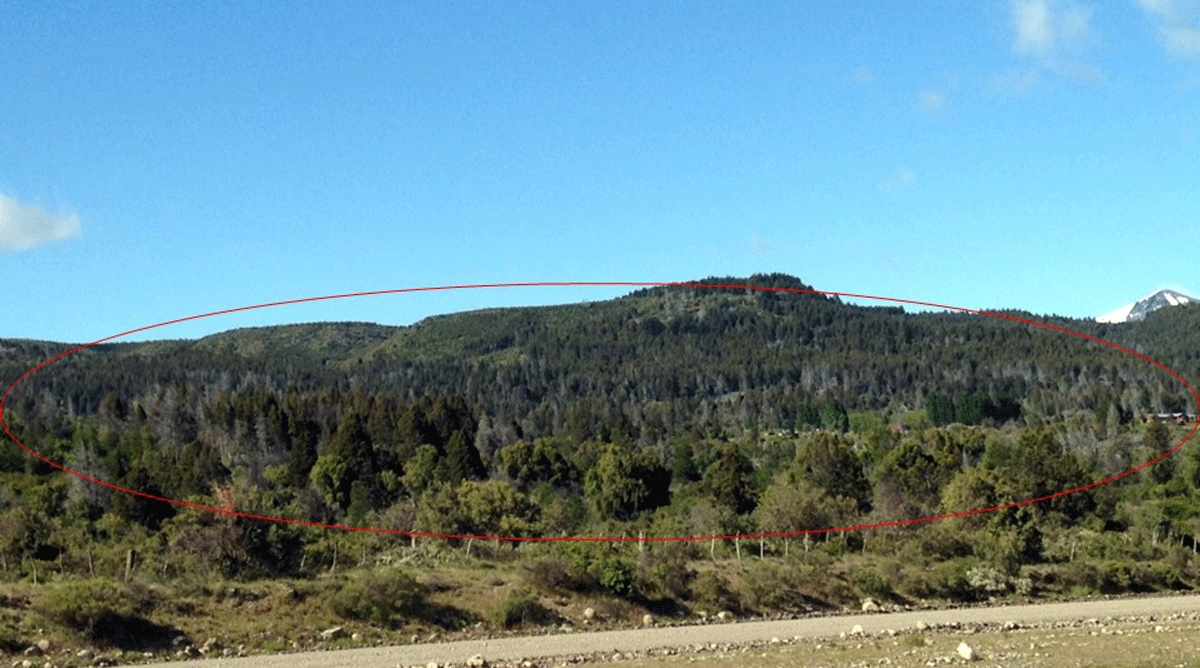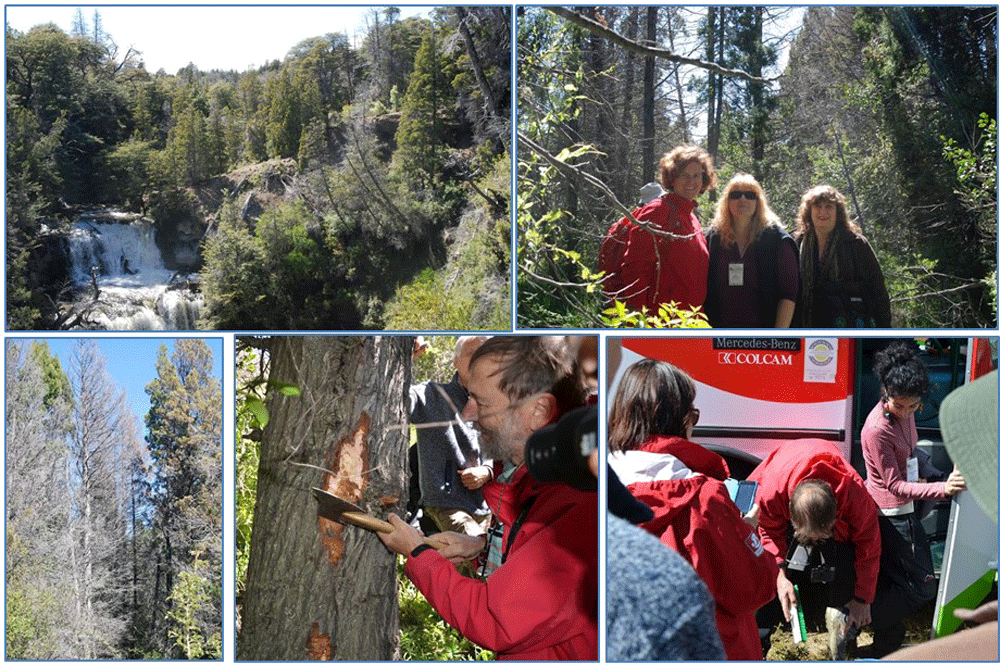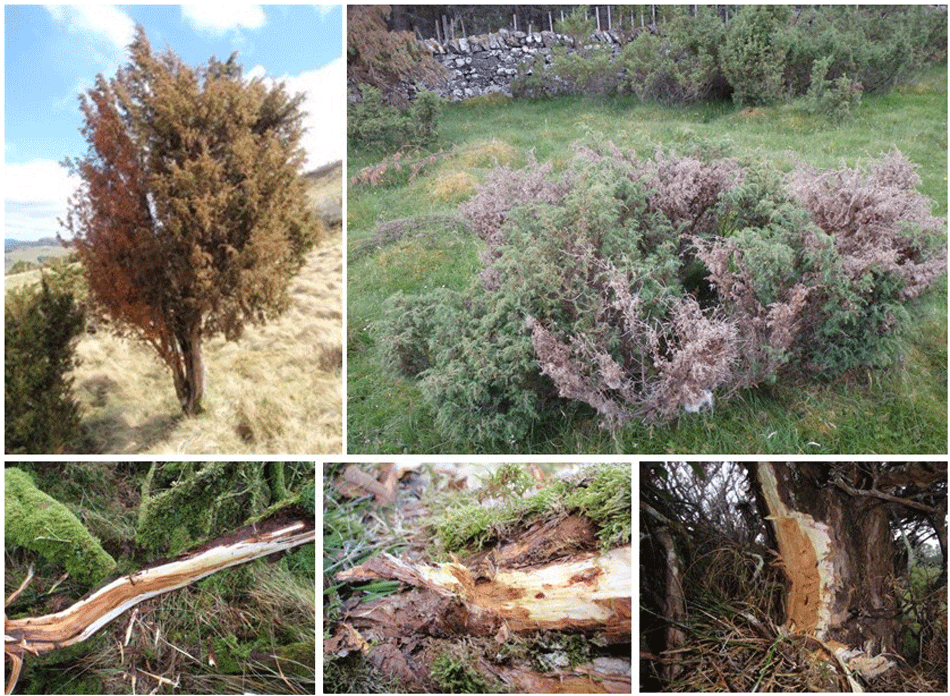Phytophthora austrocedri
|
Phytophthora spp. in subclade 8d: portion of the seven-loci ML phylogeny featuring the type cultures of 212 described species (by T. Bourret). Notice the position of P. austrocedri Ex-type CBS 122911 = S&T BL 5. Gloria Abad, USDA S&T.
|
|
Phytophthora spp. in subclade 8d: Morphological Tabular key (PDF) and Tabular key legends (PDF) in IDphy2 KEY SECTION. Notice the data of P. austrocedri Ex-type CBS 122911 = S&T BL 5. Gloria Abad, USDA S&T.
|
|
Phytophthora austrocedri (CPHST BL 5) colony of the ex-type grown for 7 days on (a) V8® Agar, (b) potato dextrose agar, and (c) malt extract agar; photo by Krysta Jennings and Leandra Knight, USDA-APHIS-PPQ |
|
Phytophthora austrocedri (CPHST BL 5, ex-type) asexual phase (a-d): sporangia semipapillate (a-b), persistent (a), caducous (b); typical hyphal swellings (c, e); photos by Gloria Abad, USDA-APHIS-PPQ
|
|
Phytophthora austrocedri (CPHST BL 5, ex-type) sexual phase (a-d): smooth-walled oogonia (a-c), sometimes with finger-like wall projections (d), amphigynous antheridia with one big cell (a-b & d), paragynous antheridium (c) also observed; photos by Gloria Abad, USDA-APHIS-PPQ |
|
Participants of the 7th IUFRO Phytophthora Working Group (November 10-14, 2014, Esquel, Patagonia, Argentina) attending presentations at Los Alerces National Park. Participants observed native forest sanitary problems, including the mortality of Austrocedrus chilensis affected with mal del cipres caused by Phytophthora austrocedri. Typical Argentinian asado in bottom right photo. photos by G. Abad |
|
Panoramic view of Los Alerces National Park where the mortality of Austrocedrus chilensis affected with mal del ciprés is observed. The disease was first detected in the area in 1935, and it was attributed to different causes. Many decades after, in 2005, the cause was attributed to Phytophthora. photo by Gloria Abad – USDA-APHIS-PPQ |
|
Symptoms of “mal del ciprés” caused by Phytophthora autrocedri and taking action to prevent the spread of the disease into healthy areas. Views in Los Alerces National Park, Patagonia Argentina during the 7th IUFRO Phytophthora; photos by Gloria Abad, USDA-APHIS-PPQ |
|
Juniperus communis infected with Phytophthora austrocedri at Glenartney Perthshire Scotland (a, c), Whitewell Cairngorms National Park Scotland (b), Juniper Gill Yorkshire England (d), and Whitewell (e). Lesion extends up the trunk forming a cinnamon-colored tongue with the healthy, white phloem around it. Photos courtesy of April Amstrong and Sara Green at Centre for Forestry and Climate Change (CFCC), Forest Research, Northern Res. Station, Roslin, Scotland |
Name and publication
Phytophthora austrocedri Gresl. & E.M. Hansen (2007)
Greslebin AG, Hansen EM, and Sutton W. 2007. Phytophthora austrocedrae sp. nov., a new species associated with Austrocedrus chilensis mortality in Patagonia (Argentina). Mycol. Res. 111: 308–316.
Corresponding author: alina@ciefap.org.ar
Nomenclature
from Greslebin et al. (2007)
Mycobank
Synonymy
≡ Phytophthora austrocedrae Gresl. & E.M. Hansen (2007) [MB#510267] (orthographic variant)
Etymology
refers to the host Austrocedrus chilensis
Typification
Type: ARGENTINA, from roots and stem of Austrocedrus chilensis (Ciprés de la Cordillera or Cordilleran Cypress) collected on Oct. 2005 by A. Greslebin in Chubut, Parque Nacional Los Alerces (CIEFAP 203, Centro de Investigacion y Extension Forestal Andino Patagonico)
Ex-type: culture ATCC MYA-4074 (AG203)
Sequences for ex-type in original manuscript: Phytophthora sp. austrocedrae isolate AG203 = ITS rDNA: DQ995184 (1194bp 18S + ITS)
Ex-type in other collections
(ET) CBS 122911, ATCC MYA-4074, AG203, CIEFAP 203, WPC P16040, Gresbelin 203, S&T BL 5 (Abad), 41B6 (Hong)
Molecular identification
Voucher sequences for barcoding genes (ITS rDNA and COI) of the ex-type (see Molecular protocols page)
Phytophthora austrocedri isolate CPHST BL 5 (= P16040 WPC) = ITS rDNA MG783380, COI MH136850
Voucher sequences for Molecular Toolbox with seven genes (ITS, β-tub, COI, EF1α, HSP90, L10, and YPT1
(see Molecular protocols page) (In Progress)
Voucher sequences for Metabarcoding High-throughput Sequencing (HTS) Technologies [Molecular Operational Taxonomic Unit (MOTU)]
(see Molecular protocols page) (In Progress)
Sequences with multiple genes for ex-type in other sources
- NCBI: Phytophthora austrocedri CPHST BL 5
- NCBI: Phytophthora austrocedri AG203 (PAU-09-002)
- NCBI: Phytophthora austrocedri P16040
- EPPO-Q-bank: Phytophthora austrocedri CBS 122.911
- BOLDSYSTEMS: Phytophthora austrocedri PHYTO117-10 = P16040 (barcoding COI & ITS)
Position in multigenic phylogeny with 7 genes (ITS, β-tub, COI, EF1α, HSP90, L10, and YPT1)
Clade clade:
a taxonomic group of organisms classified together on the basis of homologous features traced to a common ancestor
8d
Morphological identification
adapted from Greslebin et al. (2007)
Colonies and cardinal temperatures
Colonies in CMA, V8, and PDA are uniform with non-distinctive pattern and with slow growth. Minimum temperature is 3°C, optimum 15–21°C, and maximum 24°C.
Conditions for growth and sporulation
SporangiaSporangia:
sac within which zoospores form, especially when water is cooled to about 10°C below ambient temperature; in solid substrates, sporangia usually germinate by germ tubes
are produced in water cultures (soil extract or river water) and not observed in solid media. OogoniaOogonia:
the female gametangium in which the oospore forms after fertilization by the antheridium
are formed in single-strain culture in different media including CMA, V8-A, PDA, and HS with oil. OogoniaOogonia:
the female gametangium in which the oospore forms after fertilization by the antheridium
were usually formed in selective media after about 20 d.
Asexual phase
SporangiaSporangia:
sac within which zoospores form, especially when water is cooled to about 10°C below ambient temperature; in solid substrates, sporangia usually germinate by germ tubes
semipapillatesemipapillate:
pertaining to the production of shallow having papilla that are not well developed, shallow and less nipple-like than fully papillate structures
; persistentpersistent:
pertaining to sporangia that remain attached to the sporangiophore and do not separate or detach easily (cf. caducous)
; ovoidovoid:
egg-shaped, with the widest part at the base of the sporangium and the narrow part at the apex
, obpyriformobpyriform:
inversely pear-shaped, i.e. with the widest part at the point of attachment (cf. pyriform)
, limoniform, or ellipsoidellipsoid:
refers to a solid body that forms an ellipse in the longitudinal plane and a circle in cross section; many fungal spores are ellipsoidal or elliptic
frequently with distorted shapes with average size of 50 x 36 µm (22–83 µm x 15–58 µm), and produced in unbranched sporangiophores. Sporangiophores frequently have hyphal swellings. SporangiaSporangia:
sac within which zoospores form, especially when water is cooled to about 10°C below ambient temperature; in solid substrates, sporangia usually germinate by germ tubes
with hyphal projections and lateral attachment of the sporangiophoresporangiophore:
the hyphal strand on which the sporangium is formed; may be branched or unbranched to form compound sympodia or simple sympodia
are frequently observed. Hyphal swellings are usually formed in liquid and solid media and are globoseglobose:
having a rounded form resembling that of a sphere
to subglobose, catenulated and sometimes with distorted shapes. ChlamydosporesChlamydospores:
an asexual spore with a thickened inner wall that is delimited from the mycelium by a septum; may be terminal or intercalary, and survives for long periods in soil
absent.
Sexual phase
Homothallic. OogoniaOogonia:
the female gametangium in which the oospore forms after fertilization by the antheridium
produced in approx. 20 days and are globoseglobose:
having a rounded form resembling that of a sphere
[39 µm diameter (22–56 µm)] with smooth walls; antheridiaantheridia:
the male gametangium; a multinucleate, swollen hyphal tip affixed firmly to the wall of the female gametangium (the oogonium)
are amphigynousamphigynous:
pertaining to the sexual stage in which the antheridium completely surrounds the stalk of the oogonium (cf. paragynous)
; and oosporesoospores:
zygote or thick-walled spore that forms within the oogonium after fertilization by the antheridium; may be long-lived
are apleroticaplerotic:
pertaining to a mature oospore that does not fill the oogonium; i.e. there is room left between the oospore wall and oogonium wall (cf. plerotic)
.
Most typical characters
Phytophthora austrocedri is characterized by the production of persistentpersistent:
pertaining to sporangia that remain attached to the sporangiophore and do not separate or detach easily (cf. caducous)
sporangia, hyphal swellings readily formed in water and solid culture, and slow growth rate.
Additional specimen(s) evaluated
Phytophthora austrocedrae CPHST BL 5 (Abad) = (P16040 World Phytophthora Collection – California, USA) duplicate of the ex-type CIEFAP 203
Hosts and distribution
Distribution: Asia (Iran), Europe (England, Germany, Scotland), South America (Argentina)
Substrate: isolated from necrotic lesions of stems and roots
Disease note: dieback, mortality; associated with 'mal del cipres' disease
Host: Austrocedrus chilensis, Juniperus communis, Cupressus sempervirens (Cupressaceae)
Retrieved January 17, 2018 from U.S. National Fungus Collections Nomenclature Database.
Additional information: The natural host of P. austrocedrae in South America is the Chilean cedar (Austrocedrus chilensis). In the UK, Lawson cypress (Chamaecyparis lawsoniana), Nootka cypress (Chamaecyparis nootkatensis), and the common juniper (Juniperus communis) have been confirmed as hosts in 2011. https://www.forestresearch.gov.uk/research/phytophthora-austrocedri/
Quarantine status
USA: Phytophthora austrocedrae is listed in the “Additional Pests of Concern” by the National Cooperative Agricultural Pest Survey (CAPS) for 2017, 2018, and 2019.
This species was listed as a species of concern during the 2009 Phytophthora prioritization project conducted by USDA APHIS PPQ CPHST PERAL (Schwartzburg et al.).
Additional references and links
Forest Research UK Phytophthora austrocedrae
Forest Research: Phytophthora austrocedrae on juniper factsheet
- SMML USDA-ARS: Phytophthora austrocedri
- EPPO Global Database: Phytophthora austrocedri
- Forest Phytophthoras of the world: Phytophthora austrocedrae
- CABI Digital Library: Phytophthora austrocedrae
- Forest Research UK: Phytophthora austrocedri
- Encyclopedia of Life (EOL): Phytophthora austrocedrae
- Index Fungorum (IF): Phytophthora austrocedri
- Google All Phytophthora austrocedrae
- Google Images Phytophthora austrocedrae
- Google Scholar Phytophthora austrocedrae
Fact sheet author
Z. Gloria Abad, Ph.D., USDA-APHIS-PPQ-S&T Plant Pathogen Confirmatory Diagnostics Laboratory (PPCDL), United States of America.

